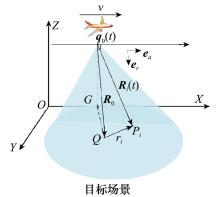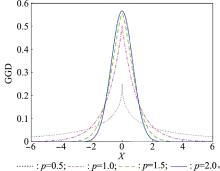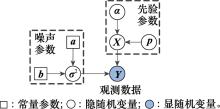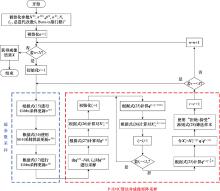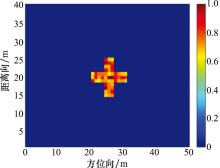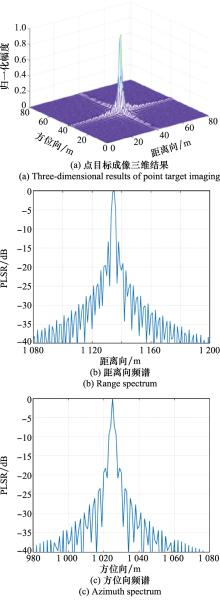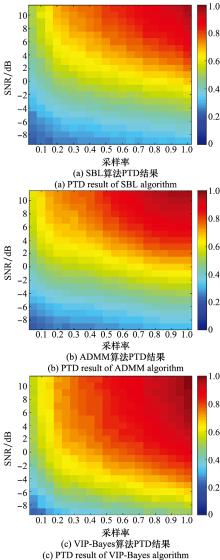Systems Engineering and Electronics ›› 2021, Vol. 43 ›› Issue (7): 1781-1790.doi: 10.12305/j.issn.1001-506X.2021.07.07
• Radar sparse signal processing technology • Previous Articles Next Articles
Sparse SAR imaging based on varying prior Bayes learning
Xiaoyun SHEN, Xianhua LIAO, Weitian SUN, Yabo XIA, Lei YANG*
- 1. College of Electronic Information and Automation, Civil Aviation University of China, Tianjin 300300, China
2. Tianjin Key Laboratory for Advanced Signal Processing, Civil Aviation University of China, Tianjin 300300, China
-
Received:2020-12-30Online:2021-06-30Published:2021-07-08 -
Contact:Lei YANG
CLC Number:
Cite this article
Xiaoyun SHEN, Xianhua LIAO, Weitian SUN, Yabo XIA, Lei YANG. Sparse SAR imaging based on varying prior Bayes learning[J]. Systems Engineering and Electronics, 2021, 43(7): 1781-1790.
share this article
| 1 |
张新征, 黄培康. 基于贝叶斯压缩感知的SAR目标识别[J]. 系统工程与电子技术, 2013, 35 (1): 40- 44.
doi: 10.3969/j.issn.1001-506X.2013.01.07 |
|
ZHANG X Z , HUANG P K . SAR ATR based on Bayesian compressive sensing[J]. Journal of Systems Engineering and Electronics, 2013, 35 (1): 40- 44.
doi: 10.3969/j.issn.1001-506X.2013.01.07 |
|
| 2 |
DONOHO D L . Compressed sensing[J]. IEEE Trans.on Information Theory, 2006, 52 (4): 1289- 1306.
doi: 10.1109/TIT.2006.871582 |
| 3 | 杨磊, 李慧娟, 黄博, 等. 双层稀疏组Lasso高分辨SAR结构特征增强成像[J]. 系统工程与电子技术, 2021, 43 (2): 351- 362. |
| YANG L , LI H J , HUANG B , et al. High resolution SAR imagery with structural feature enhancement under two-layer sparse group Lasso[J]. Systems Engineering and Electronics, 2021, 43 (2): 351- 362. | |
| 4 |
YANG L , LI P C , ZHANG S , et al. Cooperative multitask learning for sparsity-driven SAR imagery and nonsystematic error autocalibration[J]. on Geoscience and Remote Sensing, 2020, 58 (7): 5132- 5143.
doi: 10.1109/TGRS.2020.2972972 |
| 5 |
ZHOU D Y , YIN X Y , ZONG Z Y . Multi-trace basis-pursuit seismic inversion for resolution enhancement[J]. Geophysical Prospecting, 2019, 67 (3): 519- 531.
doi: 10.1111/1365-2478.12752 |
| 6 | CHEN S S , DONOHO D L , SAUNDERS M A . Atomic decomposition by basis pursuit[J]. SIAM Journal on Scientific Computing, 2001, 43 (1): 129- 159. |
| 7 | FIGUEIREDO M A T , NOWAK R D , WRIGHT S J . Gradient projection for sparse reconstruction: application to compressed sensing and other inverse problems[J]. IEEE Journal of Selected Topics in Signal Processing, 2008, 1 (4): 586- 597. |
| 8 | STEPHEN B , NEAL P , CHU E , et al. Distributed optimization and statistical learning via the alternating direction method of multipliers[M]. New York: Foundations and Trends in Machine Learning, 2011. |
| 9 |
BABACAN S D , MOLINA R , KATSAGGELOS A K , et al. Bayesian compressive sensing using laplace priors[J]. on Image Process, 2010, 19 (1): 53- 63.
doi: 10.1109/TIP.2009.2032894 |
| 10 |
WU Q , ZHANG Y D , AMIN M G , et al. High-resolution passive SAR imaging exploiting structured Bayesian compressive sensing[J]. IEEE Journal of Selected Topics in Signal Processing, 2015, 9 (8): 1484- 1497.
doi: 10.1109/JSTSP.2015.2479190 |
| 11 |
NOGUEIRA F E A , MARQUES R C P , MEDEIROS F N S . SAR image segmentation based on unsupervised classification of log-cumulants estimates[J]. IEEE Geoscience and Remote Sensing Letters, 2020, 17 (7): 1287- 1289.
doi: 10.1109/LGRS.2019.2941075 |
| 12 |
MORADIKIA M , SAMADI S , CETIN M . Joint SAR imaging and multi-feature decomposition from 2-D under-sampled data via low-rankness plus sparsity priors[J]. IEEE Trans.on Computational Imaging, 2019, 5 (1): 1- 16.
doi: 10.1109/TCI.2018.2881530 |
| 13 |
BAI X R , ZHANG Y , ZHOU F . High-resolution radar imaging in complex environments based on Bayesian learning with mixture models[J]. IEEE Trans.on Geoscience and Remote Sensing, 2019, 57 (2): 972- 984.
doi: 10.1109/TGRS.2018.2863743 |
| 14 | YANG L , ZHAO L F , BI G A , et al. SAR ground moving target imaging algorithm based on parametric and dynamic sparse Bayesian learning[J]. IEEE Trans.on Geoscience and Remote Sensing, 2016, 54 (2): 2254- 2267. |
| 15 |
WANG L , ZHAO L F , BI G A , et al. Enhanced ISAR imaging by exploiting the continuity of the target scene[J]. IEEE Trans.on Geoscience and Remote Sensing, 2014, 52 (9): 5736- 5750.
doi: 10.1109/TGRS.2013.2292074 |
| 16 | ZHAO N , BASARAB A , KOUAME D , et al. Joint segmentation and deconvolution of ultrasound images using a hierarchical Bayesian model based on generalized Gaussian priors[J]. IEEE Trans.on Image Process, 2014, 25 (8): 3304- 3319. |
| 17 | CHAARI L, TOURNERET J Y, CHAUX C. Sparse signal recovery using a Bernoulli generalized Gaussian prior[C]//Proc. of the 23rd European Signal Processing Conference, 2015. |
| 18 | ZHAO N, BASARAB A, KOUAME D, et al. Restoration of ultrasound images using a hierarchical Bayesian model with a generalized Gaussian prior[C]//Proc. of the IEEE International Conference on Image Processing, 2014. |
| 19 |
ISWARAN H . Gibbs sampling methods for stick-breaking priors[J]. Journal of the American Statistical Association, 2001, 96 (453): 161- 173.
doi: 10.1198/016214501750332758 |
| 20 |
CHAARI L , TOURNERET J , CHAUX C , et al. A Hamiltonian Monte Carlo method for non-smooth energy sampling[J]. IEEE Trans.on Signal Processing, 2016, 64 (21): 5585- 5594.
doi: 10.1109/TSP.2016.2585120 |
| 21 | NEAL R M . MCMC using Hamiltonian dynamics[J]. ArXiv: Computation, 2011, 21. |
| 22 | PEREYRA M . Proximal markov chain Monte Carlo algorithms[J]. Stats and Computing, 2016, 26 (4): 13- 34. |
| 23 | HOFFMAN M D , GELMAN A . The no-u-turn sampler: adaptively setting path lengths in Hamiltonian Monte Carlo[J]. Journal of Machine Learning Research, 2011, 15 (1): 2320- 2335. |
| 24 | PARIKH N , BOYD S . Proximal algorithms[J]. Foundations and Trends in Optimization, 2013, 1 (3): 123- 231. |
| 25 |
CORBINEAU M , KOUAMÉ D , CHOUZENOUX E , et al. Preconditioned P-ULA for joint deconvolution segmentation of ultrasound images[J]. IEEE Signal Processing Letters, 2019, 26 (10): 1456- 1460.
doi: 10.1109/LSP.2019.2935610 |
| 26 | COMBETTES P L , DUNG D , BNG C V . Proximity for sums of composite functions[J]. Journal of Mathematical Analysis & Applications, 2010, 380 (2): 680- 688. |
| 27 | 徐志林, 魏中浩, 吴辰阳, 等. 基于l1正则化的多通道滑动聚束SAR成像[J]. 系统工程与电子技术, 2019, 41 (2): 304- 310. |
| XU Z L , WEI Z H , WU C Y , et al. Multichannel sliding spotlight SAR imaging based on l1 regularization[J]. Systems Engineering and Electronics, 2019, 41 (2): 304- 310. | |
| 28 |
杨磊, 李埔丞, 李慧娟, 等. 稳健高效通用SAR图像稀疏特征增强算法[J]. 电子与信息学报, 2019, 41 (12): 2826- 2835.
doi: 10.11999/JEIT190173 |
|
YANG L , LI P C , LI H J , et al. Robust and efficient general SAR image sparse feature enhancement algorithm[J]. Journal of Electronics and Information Technology, 2019, 41 (12): 2826- 2835.
doi: 10.11999/JEIT190173 |
|
| 29 |
YANG L , BI G A , XING M D , et al. Airborne SAR moving target signatures and imagery based on LVD[J]. IEEE Trans.on Geoscience and Remote Sensing, 2015, 53 (11): 5958- 5971.
doi: 10.1109/TGRS.2015.2429678 |
| 30 | 田野, 毕辉, 张冰尘, 等. 相变图在稀疏微波成像变化检测降采样分析中的应用[J]. 电子与信息学报, 2015, 37 (10): 2335- 2341. |
| TIAN Y , BI H , ZHANG B C , et al. Application of phase diagram to sampling ratio analysis in sparse microwave imaging change detection[J]. Journal of Electronics & Information Technology, 2015, 37 (10): 2335- 2341. | |
| 31 | 吴辰阳, 魏中浩, 张冰尘, 等. 基于复近似信息传递的多通道SAR成像方法[J]. 系统工程与电子技术, 2018, 40 (6): 1249- 1254. |
| WU C Y , WEI Z H , ZHANG B C , et al. Multi-channel SAR imaging method based on CAMP[J]. Systems Engineering and Electronics, 2018, 40 (6): 1249- 1254. |
| [1] | Tian MIAO, Hongcheng ZENG, He WANG, Jie CHEN. A fast extraction method of flood areas based on iterative threshold segmentation using spaceborne SAR data [J]. Systems Engineering and Electronics, 2022, 44(9): 2760-2768. |
| [2] | Caiyun WANG, Yida WU, Jianing WANG, Lu MA, Huanyue ZHAO. SAR image target recognition based on combinatorial optimization convolutional neural network [J]. Systems Engineering and Electronics, 2022, 44(8): 2483-2487. |
| [3] | Dongning FU, Guisheng LIAO, Yan HUANG, Bangjie ZHANG, Xing WANG. Time-varying narrow-band interference suppression algorithm for SAR based on graph Laplacian embedding [J]. Systems Engineering and Electronics, 2022, 44(6): 1846-1853. |
| [4] | Minghui GAI, Su ZHANG, Weitian SUN, Yude NI, Lei YANG. Structural-feature enhancement of SAR targets based on complex value compatible total variation [J]. Systems Engineering and Electronics, 2022, 44(6): 1862-1872. |
| [5] | Penghui JI, Dahai DAI, Shiqi XING, Dejun FENG. Dense false moving targets generation method [J]. Systems Engineering and Electronics, 2022, 44(5): 1502-1511. |
| [6] | Dong CHEN, Yanwei JU. Ship object detection SAR images based on semantic segmentation [J]. Systems Engineering and Electronics, 2022, 44(4): 1195-1201. |
| [7] | Lei YANG, Su ZHANG, Minghui GAI, Cheng FANG. High-resolution SAR imagery with enhancement of directional structure feature [J]. Systems Engineering and Electronics, 2022, 44(3): 808-818. |
| [8] | Junjie WANG, Dejun FENG, Weidong HU. Two-dimensional SAR image modulation method based on time-varying materials [J]. Systems Engineering and Electronics, 2022, 44(2): 455-462. |
| [9] | Cheng FANG, Huijuan LI, Wen LU, Yumeng SONG, Lei YANG. Multi-feature enhancement algorithm for high resolution SAR based on morphological auto-blocking [J]. Systems Engineering and Electronics, 2022, 44(2): 470-479. |
| [10] | Yu LEI, Xiangguang LENG, Xiaoyan ZHOU, Zhongzhen SUN, Kefeng JI. Recognition method of ship target in complex SAR image based on improved ResNet network [J]. Systems Engineering and Electronics, 2022, 44(12): 3652-3660. |
| [11] | Xiaoya JIA, Hongqiao WANG, Yadan YANG, Zhongma CUI, Bin XIONG. Anchor free SAR image ship target detection method based on the YOLO framework [J]. Systems Engineering and Electronics, 2022, 44(12): 3703-3709. |
| [12] | Zheng XU, Guangzhong GONG, Yunhua LUO, Guangde LI. Application of improved spatial variant apodization algorithm through constrained optimization in sidelobe suppression [J]. Systems Engineering and Electronics, 2022, 44(11): 3298-3304. |
| [13] | Baoping YANG, Maogang WEI, Zhichao BAO, Linsen YANG, Xiaoyu WANG. Comparative analysis of common coherent jamming technology against SAR [J]. Systems Engineering and Electronics, 2022, 44(11): 3397-3402. |
| [14] | Guang SUN, Shiqi XING, Datong HUANG, Yongzhen LI, Xuesong WANG. Jamming method of intermittent sampling against SAR-GMTI based on noise multiplication modulation [J]. Systems Engineering and Electronics, 2022, 44(10): 3059-3071. |
| [15] | Yonggang LI, Weigang ZHU, Qiongnan HUANG, Yuntao LI, Yonghua HE. Near-shore ship target detection with SAR images in complex background [J]. Systems Engineering and Electronics, 2022, 44(10): 3096-3103. |
| Viewed | ||||||
|
Full text |
|
|||||
|
Abstract |
|
|||||
